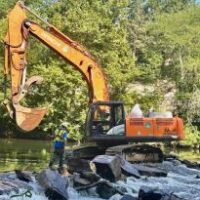
Veolia opens it’s largest PFAS treatment plant in the US at its Stanton Water Treatment facility. (Governor Matt Meyer, Veolia North America Water Services CEO Karine Rougé; National Association of Water Companies President and CEO Rob Powelson; Veolia North America Mid-Atlantic Regional President Larry Finnicum) Photo courtesy of Veolia North America.
WILMINGTON— Veolia has opened one of the largest PFAS treatment plants in the United States at its Stanton Water Treatment facility, a $35 million project designed to deliver safer drinking water to more than 100,000 New Castle County residents.
The system is now removing regulated per- and polyfluoroalkyl substances (PFAS) from up to 30 million gallons of water per day, meeting federal limits 4 years ahead of the Environmental Protection Agency’s 2029 compliance deadline.
PFAS, often called “forever chemicals,” are found in consumer goods like nonstick cookware and firefighting foam. They have been linked to a range of serious health problems, including certain cancers, thyroid disease, and developmental issues in children. These chemicals can persist in the human body for years, prompting a nationwide push for stricter regulations.
“In line with our GreenUp strategic program, this major infrastructure milestone highlights Veolia’s strong commitment to delivering environmental security solutions to communities worldwide,” said Estelle Brachlianoff, CEO of Veolia. “For the 100,000 people who rely on high-quality water from Veolia in Delaware, the Stanton PFAS treatment system is a generational improvement in public health and environmental protection that will strengthen communities and create opportunities long into the future.”
The 17,600-square-foot facility houses 42 carbon-filled vessels — each 22 feet tall and containing 40,000 pounds of granular activated carbon. Water enters from two nearby sources, including the Red Clay Creek, where high levels of PFAS had previously been detected. Once through the filters, PFAS levels are reduced to non-detectable amounts.
RELATED STORY: Wilmington Wastewater Plant seeks approval for flare replacement
Veolia began designing the system in early 2022. Construction was completed in under three years by installing the vessels first and then building the structure around them. A built-in laboratory enables Veolia to test new filtration materials and optimize treatment over time, providing flexibility as environmental standards evolve.
Currently operates 33 PFAS treatment facilities nationwide, Veolia plans to expand that number to over 100 through its “BeyondPFAS” initiative, providing water security to nearly 2 million Americans.

The 17,600-square-foot facility houses 42 carbon-filled vessels — each 22 feet tall and containing 40,000 pounds of granular activated carbon. (Photo courtesy of Veolia North America)
Governor Matt Meyer praised the project’s public health impact, particularly for households that cannot afford home filtration.
“PFAS contamination poses a serious threat to public health, and addressing it at the source is essential,” he said. “The Stanton Water Treatment Plant will play a vital role in tackling this challenge… and underscores our administration’s dedication to ensuring clean, safe water for Delawareans.”
Veolia partnered with the Delaware Department of Natural Resources and Environmental Control (DNREC) to evaluate sources of PFAS contamination. The company said about a third of its water supply comes from the Red Clay Creek, a site affected by legacy pollution. The exact source of contamination has not yet been determined.
The company has filed a request with the Delaware Public Service Commission for a 44% rate increase to help cover costs of the new system. If approved, the average residential water bill would rise by about $19 per month — from $40 to $59. Veolia has not said whether it will pursue legal action to recoup costs from chemical manufacturers, as some utilities have done.
Karine Rougé, CEO of Municipal Water for Veolia North America, said the Stanton plant represents a broader shift in how utilities respond to contamination.
“I’m inspired by how swiftly and effectively Veolia responded to the PFAS challenge in Delaware through this state-of-the-art facility, which now sets a global standard,” she said. “The lessons from this project will help Veolia deploy similar water quality improvements faster, more efficiently and more effectively.”
The EPA implemented new drinking water standards for PFAS last year, though it recently proposed giving providers more time to comply following legal challenges and concerns about treatment costs. Veolia’s early delivery may position Delaware as a national model in proactive compliance.

Claudia is a Philadelphia-based journalist and reporter passionate about storytelling that informs and engages the community. Claudia, a proud Temple University graduate, has built a career covering impactful stories and creating compelling content across digital and print media platforms. With a strong background in writing, editing, and research, Claudia has worked on various topics, from local news to in-depth features, always striving to deliver meaningful and accurate reporting editor@townsquarelive.com
Share this Post










